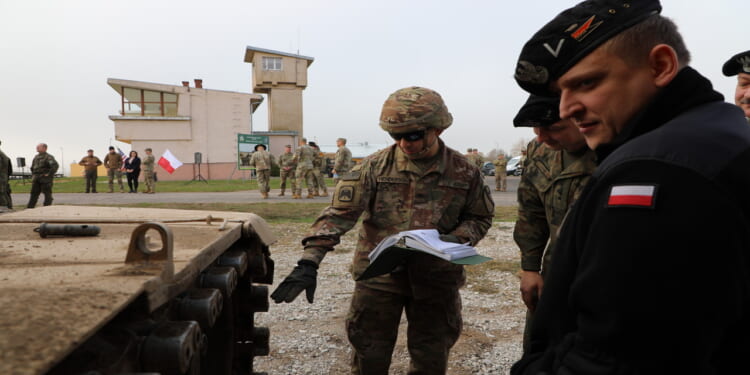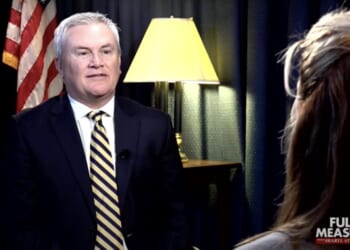Earlier this month, the Polish military tested the newest versions of the American-made M1A2 SEPv3 Abrams tanks in a live-fire exercise at the Biedrusko training ground near Poznań.
In January, NATO member Poland took delivery of twenty-eight American M1A2 SEPv3 Abrams main battle tanks (MBTs), the first batch of a planned 250 of the vehicles that Warsaw purchased in a 2022 deal with Washington via a Foreign Military Sales order.
The tanks arrived at the port of Gdynia less than three months after the first twenty-five Polish soldiers completed a nine-week training program in tank maintenance at the newly built Army Pre-position Stocks-2 (APS-2) facility in Powidz, Poland.
The remainder of the enhanced M1A2 Abrams will be delivered by the end of 2026. Warsaw’s acquisition of the American-made MBTs has been valued at $4.75 billion.
Earlier this month, the Polish military tested the tanks in a live-fire exercise at the Biedrusko training ground near Poznań.
Defence-Industry Europe reported, “Polish soldiers began Abrams training in October 2021 at a U.S. facility in Idaho. Since mid-2022, instruction has continued in Poland at the Abrams Tank Training Academy in Poznań, using earlier M1A1 SEPv2 models to prepare troops for the arrival of the SEPv3.”
The upgraded M1A2s will serve alongside the refurbished 116 M1A1 SEPv2 models delivered to Poland, which received their final batch in 2024. Those MBTs now serve with the Polish Army’s “1st Tank Battalion in Wesoła and the 19th Mechanized Brigade in Lublin.”
After the United States and Australia, Poland is the only country to operate the Abrams’ SEPv3 variant.
These New Abrams Are Not the Same as the 1980s M1 Abrams
Though the M1 Abrams first entered service when Jimmy Carter was president, and few Americans ever saw a computer, the MBT has steadily improved.
“New in the SEPv3 upgrade are additional electrical power from an auxiliary power unit, network upgrades, stronger armor for greater protection, an ammo data link to interface with advanced ammunition, and reduced maintenance strain,” General Dynamics Land Systems explained on its website.
SEPv3 was also developed to address many space, weight, and power issues identified during Operation Iraqi Freedom. It has served as a foundational variant for all future incremental upgrades.
“Armament-wise, the tank has an M256 120mm smoothbore cannon, which can fire M829A4 advanced kinetic energy and advanced multi-purpose rounds to defend the armored vehicles. Each SepV3 tank is also fitted with an enhanced forward-looking infrared to detect targets,” wrote Maya Carlin for The National Interest, adding, “More importantly, the tank has a modular design that will allow for future technologies to be incorporated more easily.”
American-Made Tanks Are at Home in Poland
Poland is receiving the newest variant of the M1 Abrams and is also home to the U.S.-built Army Pre-position Stocks-2 (APS-2), which is located in Powidz, about 250 miles from the Ukrainian border. It is a state-of-the-art depot with 650,000 square feet of humidity-controlled warehouse space for storing and maintaining various armored vehicles.
Costing more than $360 million, the new, specially designed structure can house an armored brigade combat team consisting of around eighty-five MBTs, 190 additional armored combat vehicles, including the M2 Bradley, thirty-five artillery pieces, and four armored vehicle-launched bridges.
It can also store significant ordnance in a 58,000-square-foot munitions area.
The APS-2 worksite will allow for supervised servicing and maintenance of Poland’s fleet of M1 tanks, including the SEPv3 variants.
About the Author: Peter Suciu
Peter Suciu is a Michigan-based writer. He has contributed to more than four dozen magazines, newspapers, and websites with over 3,200 published pieces over a twenty-year career in journalism. He regularly writes about military hardware, firearms history, cybersecurity, politics, and international affairs. Peter is also a Contributing Writer for Forbes and Clearance Jobs. You can follow him on Twitter: @PeterSuciu. You can email the author: [email protected].
Image: Wikimedia/ Pfc. David Dumas.















